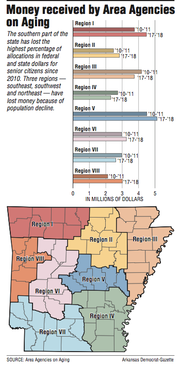South Arkansas' declining population has meant a drop in funding for its senior citizens, and legislators last week engaged in heated debate over whether to revitalize the region's programs for the aged by pulling dollars from other parts of the state.
The pot of money for the Area Agencies on Aging, which provide food and transportation and operates senior-citizen centers, has remained about the same for the past decade, but the agencies are serving more people and the costs of goods have risen, officials say.
Legislators debated adding two categories to factors the formula used when doling out money for services for senior citizens: one based on rural population and the other based on the number of people over 75. All factors are based on data from the U.S. Census Bureau.
These measures aim to assist all rural regions, and five regions would get more money, but south Arkansas stands to gain the most. All funding would change by less than a percentage point.
"This was all about fairness," said Craig Cloud, former director for the Aging and Adult Services Division of the state Department of Human Services. "It was about preventing a large decrease that had happened."
Under the proposed change, 15 percent of funding for regional Area Agencies on Aging would be based on a region's proportion of rural Arkansans who are 60 and older; 5 percent of funding would be based on the proportion of all residents 75 and older.
The change also would decrease the funding percentage based on all residents 60 and older from 50 percent to 35 percent. Twenty-five percent would be based on low-income people 60 and older, and 20 percent based on low-income minority-group populations 60 and older.
"This is a difficult situation, and there may not be a better solution to this," said David White, a deputy director for the Aging and Adult Services Division. White presented the plan to a legislative committee on Wednesday.
White said that operating rural agencies may be more expensive because the clientele live farther apart and tend to be older, so they have more needs.
Ruthie Langston, executive director of the southwest region, said that, as her agency's budget has shrunk since about 2011, she's been scrambling to make ends meet. A couple of years ago, she asked for a pay cut to try to preserve programs as the agency started working four days a week instead of five.
"Funds equals service," Langston said. "That's the way it goes, and you can't separate the two."
James Word, the interim executive director in the southeast region and a former state representative, proposed two bills concerning funding for Area Agencies on Aging while he was in the Legislature.
One died in committee. The other, which directed the Human Services Department to examine the funding formula, passed in 2013. Word said he thought the proposed formula discussed on Wednesday would be helpful and address many of the issues he faces in southeast Arkansas.
"It really would help those area agencies that kind of are really struggling," Word said. "Right now, we are struggling with our senior centers. We don't have enough funding to run those senior centers."
From fiscal 2010 to 2017, southeast Arkansas lost about 15 percent of its budget from state and federal funds -- from about $2.7 million to $2.3 million. Southwest Arkansas lost 12 percent -- from close to $3 million to $2.6 million. Both saw a slight increase in the 2018-19 year.
While rural areas would gain under the new plan, the groups in Northwest, central and western Arkansas would face budget cuts. They serve 21 of Arkansas' 75 counties.
Northwest Arkansas would lose the most money -- about $200,000 with all factors considered, including a loss of revenue from other funds dedicated to the agencies. Jerry Mitchell, executive director for the region, said Washington County would take the "hardest hit."
All eight regional executive directors met last year to discuss the change, and Mitchell was the only one to vote against it.
"It doesn't make sense to just change the process on how you're going to distribute the money because you're going to have winners and losers every year," he said.
Mitchell was the only director called on to answer questions at Wednesday's joint legislative Committee on Aging, Children and Youth, Legislative and Military Affairs meeting, although Langston said she wrote her name down, requesting to comment.
The committee didn't vote because not enough members were present, although the vote would have been a courtesy. The measure will next head to Administrative Rules and Regulations for a vote on Tuesday.
Rep. Charlene Fite, R-Van Buren, opposed the change, saying that a hungry person should be fed no matter where they live. Fite's district stands to lose the most money in the formula change.
"It should not matter where in the state they live," she said during a later interview. "We should not be taking money away from one area to put in another area. If we need more money, we should add more money."
Rep. Michelle Gray, R-Melbourne, attended the meeting to speak in favor of the rule change, but left partway through after a heated exchange with Fite. Gray supported a 2017 bill, which didn't pass, that would have made similar changes to the funding formula.
At the meeting Gray said it was "frustrating" to hear Fite's opposition and line of questioning that she thought was attempting to shut down the project at the very end of the study process.
The issue is that there isn't enough money to go around, which is compounded by a population that is living longer and dwindling revenue, said Luke Mattingly, executive director for CareLink, the agency in central Arkansas.
The agencies are funded in part by the state's cigarette tax, for which receipts are declining, White said.
Mattingly and Mitchell said the agencies also used to split close to $1 million per year out of the state's General Improvement Fund. That money stopped coming after the fund became embroiled in public-corruption scandals.
"The real issue is there's just not enough money in the system," Mattingly said. "Anytime you change the funding formula, you're just moving the money from one area to another."
Mattingly's agency would take $71,000 in cuts under the rule change, but he said he still voted at the directors' meeting in favor of it because it would hurt his agency the least.
He said it's been about a decade since money for the agencies was increased at the state or federal level, but costs of goods and the numbers of people the groups are serving have gone up.
Jennifer Hallum, executive director for the western region, said she did the same. She added that in every proposal presented at the meeting, her region would lose money. She would lose $137,000 to Crawford and Sebastian counties under the new plan.
"Nobody gets elected saying they're going to raise taxes," Hallum said. "Nobody on a budget committee says they want to increase spending. ... All the AAA [Area Agencies on Aging] are together, so if one of us wins, that means that someone else has to lose."
SundayMonday on 09/16/2018

